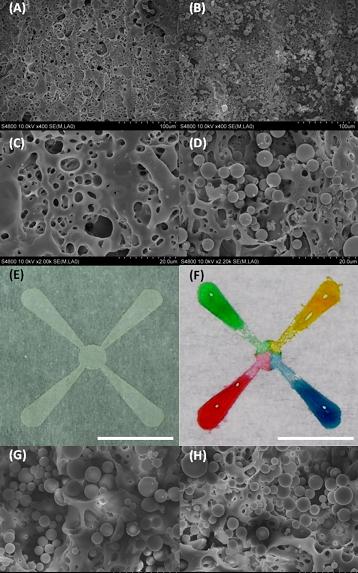We’re at the cusp of integrating miniaturized electronics and monitoring into engineered tissues and organs.
At the start of the 2009 Star Trek reboot (this is relevant, trust me), the USS Kelvin’s captain meets the enemy on their ship to try to negotiate a cease-fire. His crew uses a kind of sensing technology to track his vital signs—like heart rate, breathing, body temperature—right up to the moment of his untimely demise.
Researchers have invented a technique that uses inexpensive paper to make “microfluidic” devices for rapid medical diagnostics and chemical analysis.
 Colored water is used to show how liquid wicks along tiny channels formed in paper using a laser, in research to develop a new technology for medical diagnostics and chemical analysis. Silica microparticles were deposited on patterned areas, allowing liquid to diffuse from one end of a channel to the other. (Birck Nanotechnology Center, Purdue University)
Colored water is used to show how liquid wicks along tiny channels formed in paper using a laser, in research to develop a new technology for medical diagnostics and chemical analysis. Silica microparticles were deposited on patterned areas, allowing liquid to diffuse from one end of a channel to the other. (Birck Nanotechnology Center, Purdue University)
The innovation represents a way to enhance commercially available diagnostic devices that use paper-strip assays like those that test for diabetes and pregnancy.
This is a preview of Biomems Innovation- Make Lab on chip using paper for Medical Diagnostics.
Read the full post (960 words, 2 images, estimated 3:50 mins reading time)
Oxygen Uptake in the Lungs is Increased About 70X by Hemoglobin in the Red Cells
- In the lungs oxygen must enter the blood
- A small amount of oxygen dissolves directly in the serum, but 98.5% of the oxygen is carried by hemoglobin
- All of the hemoglobin is found within the red blood cells (RBCs or erythrocytes)
- The hemoglobin content of the blood is about 15 gm/deciliter (deciliter = 100 mL)
- Red cell count is about 5 million per microliter
Each Hemoglobin Can Bind Four O2 Molecules (100% Saturation)
This is a preview of OXYGEN CARRIED IN BLOOD WHEN PERSON IS AT HIGH ALTITUDE-TUTORIAL PHYSIOLOGY.
Read the full post (1205 words, 4 images, estimated 4:49 mins reading time)

 Colored water is used to show how liquid wicks along tiny channels formed in paper using a laser, in research to develop a new technology for medical diagnostics and chemical analysis. Silica microparticles were deposited on patterned areas, allowing liquid to diffuse from one end of a channel to the other. (Birck Nanotechnology Center,
Colored water is used to show how liquid wicks along tiny channels formed in paper using a laser, in research to develop a new technology for medical diagnostics and chemical analysis. Silica microparticles were deposited on patterned areas, allowing liquid to diffuse from one end of a channel to the other. (Birck Nanotechnology Center,